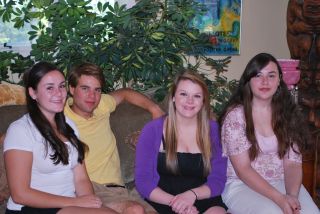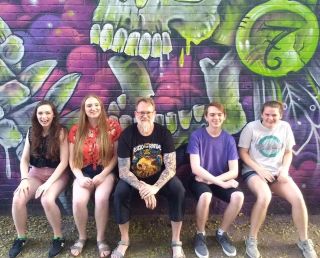Family Dynamics
Donor Families: Mutual Consent Contact
Personal Perspective: Mutually agreed-upon contact can be quite different.
Posted June 19, 2024 Reviewed by Ray Parker
Key points
- Donors, parents, and donor-conceived people can desire contact with their own or their child's DNA relatives.
- There are several methodologies for searching and finding donor relatives.
- All donor family members can make themselves available for mutual consent contact at any time.
- Early establishment of donor-family relationships is advantageous for psychological and medical reasons.

Ryan and I started the Donor Sibling Registry (DSR) in 2000. It was based on the idea that while my son's donor had signed up (had no choice) to be anonymous, Ryan was interested to know whether the guy might be curious about the children who shared ~50% of his DNA. Also, he wondered if he had any half-siblings out there: people with whom he shared a biological father. The concept of mutual consent contact was important to us, as we didn’t want to “out” anyone; we wanted to create a platform where we could facilitate mutually desired contact. As a young child (then 10), Ryan had been thinking about half-siblings and his biological father this way: “What if they want to know me, and I want to know them—how will we ever have the opportunity to find each other?”
Fast-forward to 2004, when a DNA testing company asked us if Ryan would like to test his DNA to find out more about his paternal countries of origin. We jumped at the opportunity, feeling that any new information about Ryan’s ancestry would be more than the sperm bank gave us. Neither of us nor the DNA company ever entertained the idea that Ryan’s biological father might be found using this new genetic testing technology, as that had never been done.
At first, the DNA test did provide some interesting information about where Ryan’s paternal ancestors hailed from. He thought that was cool, and we both thought that was the end of that part of the story. Nine months later, though, we received notification that Ryan had been matched with two very distant relatives. It was with the last name of these two Y-DNA connections, a public records search, and Google that nine days later led us to Ryan’s biological father.1
The irony didn’t escape us—here were the two founders of a mutual consent contact organization for connecting donor-conceived people with their first- or second-degree genetic relatives, and now we had, almost by accident, identified my son’s biological father—a guy who the sperm bank told, and who believed that he would remain anonymous. Ryan had become the first donor-conceived person to locate his donor via DNA testing.2 He might have been the first, but certainly not the last, as he opened a door that could never be closed again.
Since then, we’ve been sending DSR members to DNA testing both to confirm relatedness with donor relatives found on the DSR and to supplement their search for their donors/biological parents and siblings unaware of their origin story. DNA is often the only way for people who were born from the 1940s through the early 1980s to find genetic relatives, as most don't have the luxury of an easily matched sperm bank donor number.

Mutual-Consent Connections
People connect with donor relatives for a variety of reasons, and interest levels vary. Some only want to share and update medical information, while others feel more ambiguous and uncertain as to what type of contact and relationships they’re looking to establish but are open to exploring the possibilities. Thousands are longing to establish relationships with their own or their child’s half-siblings or hoping to find their own or their child's biological parents. There are also thousands of donors hoping to connect with their biological children, and even donor's children and parents wanting to expand their families to include donor relatives.
By searching on the DSR, you can be assured that any results you’re provided will come with the certainty and confirmation that the person you’re connecting with will not be shocked by the news that they are donor-conceived. Donors who have made themselves available are open to some type of information sharing or relationship, and chances are, most will be thrilled to make the match. More than a generation of donor-conceived people have now been able to grow up knowing their half-siblings and/or their biological parents. Medical updates and information, messages, and photos are easily shared.
Commercial DNA Testing Connections
Adult donor-conceived people also come to the DSR from the DNA testing sites to make their connections after finding out the surprising news that one of the parents who raised them wasn’t, in fact, biologically related to them. Many who were unaware of their origin story are doing DNA testing for various reasons: it was a gift, medical reasons, a passion for genealogy, or they suspect there’s a secret. The level of shock, disbelief, surprise, curiosity, and confusion varies among these people, who quite often had no idea about their donor conception and/or no idea about how many of their genetic relatives were already connected.
Because it's common for DNA testing to provide first- and second-degree genetic relatives, these results are exposing long-held family secrets that can affect entire families. Parents who thought they’d keep the secret of using a donor are now being confronted by children who wonder why their parents were not truthful with them. Some of Ryan's half-siblings have come via the DSR and some have been shocked by their DNA results. For his half-siblings who still don't know the methodology of their conception, we feel that it’s only a matter of time until they, too, stumble their way into our half-sibling family, which is now at 30.
Establishing new friendships and familial relationships via DNA testing with people who aren’t necessarily prepared for this type of new-relative connection can be a very different and much more challenging experience than making deliberate mutual consent contact. Connecting via DNA websites can be so shocking that some people are just not prepared to acknowledge or reply to messages from their new-found relatives. While some donors are thrilled to be found, others fear that their long-held donation secret will be exposed to family and friends or that more than 100 offspring will flood through an opened door. Some discard messages thinking their connections are some kind of scam, e.g., having 20 half-siblings is impossible. Relatives of donors feel awkward or confused when contacted by their family members' progeny. For those waiting for a reply that never comes or having a door quickly shut, this can be difficult.
No Need to Wait
Why not allow children to grow up knowing their close genetic relatives? We sometimes hear that parents and donors want to stall connections until children are over 18. When relationships are defined and normalized when a child is young, that eliminates confusion. Parents and other parents and/or donors can agree on what type of relationship they are open to exploring friendship, family, medical information sharing, etc. Ryan’s biological father wasn’t sure at first how to define the relationship with a 15-year-old donor child, but indicated that he was open to exploration, and the relationship was given the necessary space to evolve over the years. A bonus: Ryan was also able to establish a loving relationship with the donor's parents and his grandparents.
We don't wait until our children are adults to meet their cousins. Why would we wait for half-siblings? Instead of waiting for you or a relative to be contacted via DNA, you can establish contact right from the start. When parents and donors don’t disclose early or keep their children from growing up knowing their half-siblings, unnecessary emotional turmoil and confusion become inevitable.
Sperm Banks
Years from now, when society looks back on the donor conception practice of deliberately keeping a person from their close relatives, family medical history and updates, and ancestry for the first 18+ years of life, many in the industry will claim that they didn't know better. Or that there wasn't sufficient research available. But we do know better, via 24 years of anecdotal reporting from almost 100,000 DSR members, with more than a quarter of them connected to their donor family members, and through dozens of research studies and published papers3. We can all be doing better to mitigate difficult donor-family situations by adequately counseling and educating donors and parents on the medical and psychological benefits of early mutually desired contact. In the meantime, the sperm banks, like dozens of egg facilities4, can start notifying these folks about the importance of early half-sibling and donor mutual consent contact.
References
1. 10/17/2013 NPR: Lost then found.
2. Washington Post, 11/13/2005. Found on the Web, With DNA: a Boy's Father
New Scientist Magazine, 11/3/2005. Anonymous Sperm Donor Traced on Internet.




